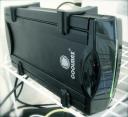Video Server, Part 1: Hardware
This is the first in a series of articles that will detail the tools and methods I’m using for my personal media server at home. Part 1: Hardware gets the ball rolling with an in-depth look at the physical devices that power my system. Future articles will detail ripping, encoding, integration and disaster management.
 The heart of the system is Wilbur, a 1.42 Ghz G4 Mac Mini with 1G RAM. I’m not ashamed to admit that I love this little guy. It’s quiet, reliable, Unix-based, and it’s never given me an ounce of trouble. That being said, though, it could be faster. While fine for day to day tasks, and a great desktop, it just can’t cut it when it comes to the heavy lifting. Enter Clyde.
The heart of the system is Wilbur, a 1.42 Ghz G4 Mac Mini with 1G RAM. I’m not ashamed to admit that I love this little guy. It’s quiet, reliable, Unix-based, and it’s never given me an ounce of trouble. That being said, though, it could be faster. While fine for day to day tasks, and a great desktop, it just can’t cut it when it comes to the heavy lifting. Enter Clyde.
 Clyde is an Intel 2.8 Ghz P4 with 1GB RAM, running Windows XP. Clyde is not super fast, but he’s faster than Wilbur, so I use him for ripping and encoding. In addition to saving me time, using Clyde instead of Wilbur means I don’t have to tie up the machine I actually like to use.
Clyde is an Intel 2.8 Ghz P4 with 1GB RAM, running Windows XP. Clyde is not super fast, but he’s faster than Wilbur, so I use him for ripping and encoding. In addition to saving me time, using Clyde instead of Wilbur means I don’t have to tie up the machine I actually like to use.
 Each machine has a 500GB SATA HDD. Clyde’s is internal, but Wilbur’s drive is mounted in an external FireWire enclosure. This setup has proven not only fast enough to stream video, but substantially faster than the internal drive. I’m currently using an enclosure from a company called Coolmax
Each machine has a 500GB SATA HDD. Clyde’s is internal, but Wilbur’s drive is mounted in an external FireWire enclosure. This setup has proven not only fast enough to stream video, but substantially faster than the internal drive. I’m currently using an enclosure from a company called Coolmax. It’s ok, but it will eventually get phased out, in favor of another solution that has an added FireWire port for daisy-chaining… and better matches the aesthetics, of course.
 The final piece of the hardware puzzle is the AppleTV
The final piece of the hardware puzzle is the AppleTV. This is the box that connects the TV to the network, and streams music, video and photos from a machine running iTunes. It’s slick, it’s easy to install, and it works great. One thing to be aware of, however, is that it only works with HDTVs.
Up next: Ripping.